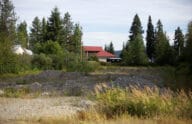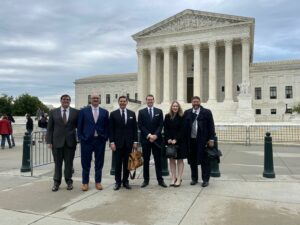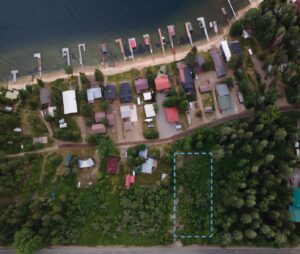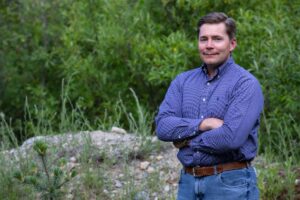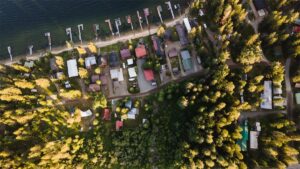Frequently asked questions about Sackett v. EPA
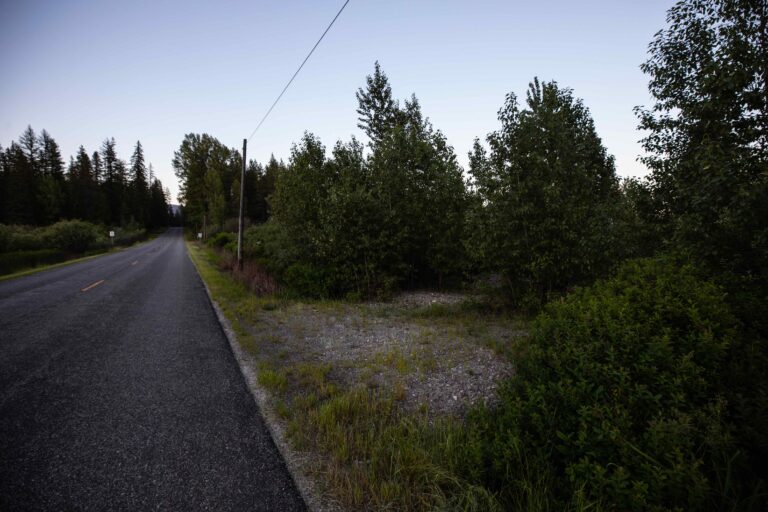
Mike and Chantell Sackett bought a parcel of land in 2004 near Priest Lake, Idaho, with dreams of building their family home on the site. Construction began in 2007—but stopped almost immediately when the Environmental Protection Agency (EPA) stepped in and issued a compliance order, claiming their land is a federally protected wetland and accusing them of violating the Clean Water Act. The Sacketts, threatened with fines of tens of thousands of dollars per day, halted their homebuilding project while fighting back in court.
That was 15 years ago. Since then, the Sacketts have traveled a tortuous path seeking justice through the lower courts; winning a procedural victory at the U.S. Supreme Court in 2012; and working back through the lower courts.
Now, the Sacketts’ Kafkaesque journey is nearing its end, as the Supreme Court will hear their case a second time to clarify the central question: What is the scope of the EPA’s power to regulate private land under the Clean Water Act?
Pacific Legal Foundation (PLF) has represented the Sacketts in their challenge throughout this difficult legal process. The following is a Q&A of the Sacketts’ long-running case to bring you up to speed in advance of the Supreme Court’s taking up Sackett v. EPA II in the Court’s fall term.
What is the legal question in Sackett II?
In Sackett II, the fundamental question is whether Mike and Chantell Sackett need permission from the EPA to build their family home.
The Clean Water Act regulates the discharge of “pollutants” from “point sources” to “navigable waters,” defined as “the waters of the United States, including the territorial seas.” The EPA has taken the highly dubious position that the Sacketts’ land—located within a residential subdivision—is a “navigable water” under their jurisdiction and therefore requires a federal permit for construction. The Sacketts’ failure to acquire a federal permit (although they had satisfied all local permitting requirements) violated the Clean Water Act, according to the EPA. The Sacketts were blindsided by that order because their property contains no stream, river, lake, or similar water body.
The Sacketts argue that the EPA’s CWA authority over wetlands extends only to those wetlands that are inseparably bound up, by means of a continuous surface water connection, to “waters of the United States,” which are water bodies subject to Congress’ authority over the channels of interstate commerce. The Sacketts’ residential lot contains no surface water connection to any water, and the EPA lacks the authority to regulate the Sacketts’ lot.
When will the case be argued in the Supreme Court, and when will its decision be issued?
The Court will hear argument in Sackett v. Environmental Protection Agency on October 3, 2022, with a decision to come sometime afterward, likely before June 2023.
Where is the Sacketts’ property located, and what is its current status?
The Sacketts bought their property near Priest Lake, a popular vacation and recreation destination for boating, swimming, and other outdoor activities in Idaho’s north panhandle, in 2004. Their property, which is two-thirds of an acre, is located in an existing residential subdivision that has been built out along the southwestern shore of the lake. The lot has a sewer hook-up and is bordered by other parcels of land that already have single-family homes on them. Other houses have been constructed nearby along the lakeshore, separated from the Sacketts’ property by a road. The Sacketts’ lot does not abut the lake, nor does it have any surface water connection to the lake.
The Sacketts’ property has sat unused for 15 years, as their construction project has been unable to proceed.
Wasn’t this case already won at the Supreme Court? Why are you back again, and why has it taken so long?
The first time the Sacketts went to the Supreme Court in 2012, they were simply fighting to get their day in court. The lower courts held that the Sacketts did not have the right to challenge the EPA’s compliance order in court. In a unanimous decision, the Supreme Court held that the Sacketts did have the right to sue. This procedural victory allowed their case to proceed through the lower courts.
The second case, which will be heard this year, now goes to the heart of the matter—that is, does the EPA have authority under the Clean Water Act to stop the Sacketts’ homebuilding project until they obtain a permit from the federal government? This case gives the Supreme Court an opportunity to establish a clear and defined rule for federal jurisdiction under the Clean Water Act.
How does this case relate to the Supreme Court’s decision in West Virginia v. EPA?
Although the statutes in West Virginia v. EPA and Sackett II are different—West Virginia v. EPA concerned the Clean Air Act, while Sackett II concerns the Clean Water Act—at issue in both cases is agency overreach.
An agency has only the authority granted to it by Congress. Agencies overstep that authority when they regulate beyond what Congress allowed. In West Virginia v. EPA, the Court held that the EPA overstepped that authority by requiring power plants to shift from traditional energy resources like coal to “green energy” sources like wind and solar. In Sackett II, the Sacketts argue that the EPA overstepped its authority when it asserted federal jurisdiction over the Sacketts’ homebuilding site.
When was the Clean Water Act passed? And why?
The Clean Water Act (CWA) was enacted into law in October 1972. The CWA regulates the discharge of “pollutants” from “point sources” to “navigable waters,” which the Act defines as “the waters of the United States, including the territorial seas.” But over the course of 50 years, the EPA and the Army Corps of Engineers, the two federal agencies that administer the law, have radically expanded the scope of their power beyond what was granted by the statute. According to the agencies, even dry land can be regulated as a “navigable water.”
The problem is that the Clean Water Act is being deployed as a land-use tool under which federal bureaucrats dictate, in an arbitrary and haphazard manner, how property owners use their land. Land-use decisions are better handled at the state and local levels, but under the EPA’s gradual accretion of regulatory power, the agency has arrogated these land-use powers to itself.
That radical expansion of the law happened without any congressional action. Rather than amending the law through the legislative process, unelected executive branch bureaucrats have simply expanded the law’s scope unilaterally through the regulatory process—an increasingly common practice on the part of regulatory agencies.
What are some of the harms caused by the EPA’s overreach?
The harms caused by the EPA’s egregious administration of the Clean Water Act extend well beyond the Sacketts’ case to property owners around the country who have been sued by the federal government for having used their land without first obtaining a Clean Water Act permit.
Many of these cases have entailed criminal penalties. And even when they haven’t been criminal, the civil penalties have been immense. An example is a farmer being fined more than a million dollars because they plowed parts of their field that the EPA claimed were under the agency’s jurisdiction.
Taking land out of productive use through regulation means less housing construction, less farming, less industrial activity. These limitations have a clear impact on the economic growth and prosperity that private property ownership serves to nurture.
What is the Rapanos decision, and how does it relate to the Sacketts’ case?
In the Supreme Court’s 2006 Rapanos v. United States decision, the Court held that the EPA’s and the Army Corps’ regulations asserting control over all tributaries to traditionally navigable waters and all wetlands adjacent to those tributaries were invalid under the Clean Water Act, but the Court splits on the rationale. Writing for the plurality, Justice Antonin Scalia concludes that only those wetlands with a “continuous surface water connection” to waters of the United States are subject to federal regulation under the Act. Justice Anthony Kennedy, writing for himself, instead concludes that a wetland may be regulated if it, either alone or in combination with “similarly situated” wetlands in the “region,” significantly affects the physical, chemical, and biological integrity of navigable waters.
These two different tests for wetlands jurisdiction cause significant confusion, and lower courts have applied the 2006 case unevenly. The agencies also have struggled to promulgate a workable rule regarding “navigable waters” since Rapanos. The result is a confusing patchwork of regulations that are inconsistently applied across the country.
The Court’s decision in Sackett II should clarify the scope of the EPA’s authority over wetlands under the CWA.
If the Supreme Court should decide in favor of the Sacketts, what happens then?
A Supreme Court victory would be a long-delayed vindication for the Sacketts, who could finally build their home after 15 years of delays imposed by hostile executive branch agencies and lower courts that have been overly deferential to those agencies’ claims.
But the issues at play here go far beyond one family’s construction project. It could potentially free up millions of acres of land for productive activity, like home construction, farming, or any other land-related resource activity.
What would a loss at the Supreme Court mean?
A loss at the Supreme Court would be personally devastating for the Sacketts, who have fought long and hard to affirm the right to develop their property without having to endure abuse and harassment from an unaccountable administrative bureaucracy.
But the significance goes far beyond the effect on one family: A loss at the Supreme Court would embolden the agencies to continue using the Clean Water Act to regulate all sorts of land use in the country. These agencies have already reached far beyond their mandates to assert control over farming, homebuilding, and other activities, and should the decision go against the Sacketts, the agencies will push further.
Wouldn’t limiting agencies’ ability to enforce the law serve to eviscerate the Clean Water Act and other important environmental protections?
Not at all. It’s important to recognize that, should the Supreme Court decide in the Sacketts’ favor, the EPA can still regulate the discharge of pollutants from point sources to regulated waters.
Why should Americans care about this case?
The Sacketts’ case should matter to all Americans for a number of reasons. For one, the Sacketts’ case concerns whether one has the right to reasonable use of one’s property, which is important to anybody in the country who owns land or cares about protecting the institution of private property.
But furthermore, the case is important for reinforcing that we live in a nation where the government is bound by the rule of law. If executive branch agencies are allowed to abuse their authority, in violation of law, then it would mean there is no limit to the power of federal bureaucrats in any agency.


